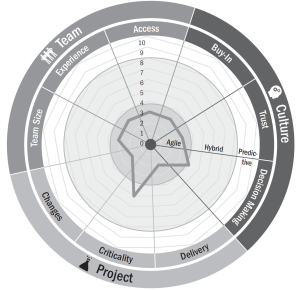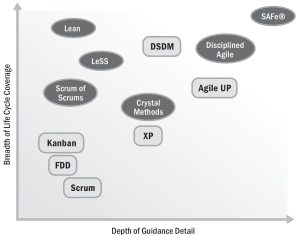The agile mindset is the foundation of all agile frameworks and practices. It goes beyond processes and tools, shaping how teams think, act, and deliver value. Task 2 of the PMI-ACP Exam Content Outline, “Embrace Agile Mindset,” focuses on developing the ability to apply agile thinking to real-world complexity, organizational contexts, and team dynamics. Rather than relying solely on prescribed methods, agile practitioners are expected to internalize agile values and principles, interpret complex situations, choose suitable approaches, and evolve their practices to match their environment.
This task encourages future agile leaders to make decisions based not only on process knowledge, but also on cultural, contextual, and complexity-based awareness — leading to better outcomes, improved adaptability, and a more sustainable path to agility.
Enabler 1: Use Agile Values and Principles
Agile values and principles serve as a compass for navigating uncertainty and complexity. They guide decisions when trade-offs arise, encouraging collaboration, adaptability, and value delivery over rigid process adherence. Applying these principles consistently helps ensure alignment with stakeholder needs and builds trust across the delivery lifecycle.
Thought leaders in the software industry formalized the agile movement in 2001 with the publication of the Manifesto for Agile Software Development:
We are uncovering better ways of developing software by doing it and helping others do it. Through this work we have come to value:
Individuals and interactions over processes and tools
Working software over comprehensive documentation
Customer collaboration over contract negotiation
Responding to change over following a plan
That is, while there is value in the items on the right, we value the items on the left more.
In practice, using agile principles means prioritizing customer collaboration over strict contracts, enabling frequent delivery of working product increments, and empowering self-organizing teams. For instance, a team may decide to replace lengthy documentation with direct discussions to improve clarity and speed — a reflection of the principle that face-to-face conversation is the most effective method of communication.
Twelve clarifying principles flowed from the values above are:
- Our highest priority is to satisfy the customer through early and continuous delivery of valuable software.
- Welcome changing requirements, even late in development. Agile processes harness change for the customer’s competitive advantage.
- Deliver working software frequently, from a couple of weeks to a couple of months, with a preference to the shorter timescale.
- Business people and developers must work together daily throughout the project.
- Build projects around motivated individuals. Give them the environment and support they need, and trust them to get the job done.
- The most efficient and effective method of conveying information to and within a development team is face-to-face conversation.
- Working software is the primary measure of progress.
- Agile processes promote sustainable development. The sponsors, developers, and users should be able to maintain a constant pace indefinitely.
- Continuous attention to technical excellence and good design enhances agility.
- Simplicity—the art of maximizing the amount of work not done—is essential.
- The best architectures, requirements, and designs emerge from self-organizing teams.
- At regular intervals, the team reflects on how to become more effective, then tunes and adjusts its behavior accordingly.
One common challenge is applying agile principles selectively or only when convenient. Teams may claim to be agile while still clinging to command-and-control structures or resisting change. To truly embrace the mindset, agile principles must become part of daily decision-making, not just a poster on the wall. Regular reflection in retrospectives, coaching conversations, and planning sessions can help teams realign with these principles over time.
Enabler 2: Apply the Appropriate Complexity Method/Domain to the Complexity Theory System
Agile practices are most effective in complex and uncertain environments. To apply them wisely, practitioners must understand the nature of the work and match their approach accordingly. Complexity classification frameworks — such as the Stacey Matrix, the Cynefin Framework, and the Complex Adaptive Systems (CAS) view — help teams assess whether a given challenge requires agility, predictability, or a hybrid response.
Note:
- Cynefin Framework is a conceptual framework used to diagnose cause-and-effect relationships as a decision-making aid.
- Stacey Matrix is similar to the Cynefin Framework, but it looks at two dimensions to determine the relative complexity of a project: (a) the relative uncertainty of the requirements for the deliverable, and (b) the relative uncertainty of the technology that will be used to create the deliverable.
- Complex Adaptive System (CAS) is a system that is complex in that it is a dynamic network of interactions, but the behavior of the ensemble may not be predictable according to the behavior of the components.
For example, the Cynefin Framework distinguishes between simple, complicated, complex, and chaotic domains. Agile methods are well suited to the complex domain, where cause-and-effect relationships can only be understood in retrospect. In such situations, teams must probe, sense, and respond — experimenting and adapting as they learn more. A new product development effort with unknown user needs would fall into this category.
Using these frameworks helps prevent the misapplication of agile to environments better served by predictive approaches, such as routine manufacturing or regulatory reporting with stable requirements. Conversely, assuming a project is simple when it is actually complex can result in overconfidence, rework, and stakeholder frustration. Accurately diagnosing the domain of complexity allows for the intentional and appropriate use of agile.
Enabler 3: Identify the Application and Importance or Risks of Each Complexity System Theory Given a Specific Scenario
Once complexity domains are understood, it becomes critical to interpret their implications for planning, delivery, and leadership. Each system theory has strengths and limits — and choosing the wrong approach introduces risks.
For instance, Complex Adaptive Systems emphasize that agile teams are dynamic, learning organisms. They thrive when given autonomy, feedback, and a safe-to-experiment environment. Applying a rigid, linear plan to such a system can suppress adaptation and innovation.
The Stacey Matrix clarifies that high levels of uncertainty in both requirements and technology demand iterative delivery and continuous stakeholder engagement. Misjudging this and defaulting to traditional plans can delay value delivery and reduce responsiveness to market shifts.
Understanding the risks of misapplication is just as important as understanding the models themselves. If an organization insists on fixed timelines in a truly complex scenario without room for iteration or feedback, the risk of failure escalates. Recognizing these mismatches enables agile practitioners to advocate for context-aware delivery strategies and improve outcomes through better planning models.
Enabler 4: Interpret the Output of Agile Suitability Tools
Before initiating agile practices, especially in hybrid or transitioning environments, practitioners may use agile suitability tools to assess readiness. These tools evaluate factors like team maturity, stakeholder availability, technological volatility, and organizational culture.
Agile suitability tools help teams assess whether a project environment is best served by an agile, hybrid, or predictive approach. These tools do not give binary answers but instead provide structured input for meaningful discussions.
One such tool is the Agile Suitability Radar Chart, which evaluates three core categories:
- Culture – including trust, buy-in, and team autonomy
- Team – such as size, experience, and access to stakeholders
- Project Characteristics – including likelihood of change, criticality, and potential for incremental delivery
Each dimension is rated on a 1–10 scale, and the results are plotted on a radar chart. Scores clustered toward the center indicate a strong fit for agile; scores on the outer edge suggest a better fit for predictive methods; and middle scores often suggest a hybrid approach.
For more information, refer to Appendix X3: Agile Suitability Filter Tools in the Agile Practice Guide.
Practitioners must interpret these outputs in context. For example:
- If the chart points toward a predictive approach, but the team wants to proceed with agile, they may still do so — but must manage the associated risks (e.g., lack of trust, high criticality).
- Conversely, if the team scores high for agile but operates in a rigid organization, cultural or governance adjustments may be necessary.
Ultimately, interpreting these tools isn’t about rigid decisions — it’s about recognizing complexity, fostering dialogue, and selecting the approach that aligns with the environment and stakeholder expectations.
Enabler 5: Integrate Agile Models Based on Needs (e.g., Use Case, Team, Project, Organization)
Agility is not one-size-fits-all. Mature agile practitioners combine elements from various frameworks — such as Scrum, Kanban, XP, Lean, SAFe, or Disciplined Agile — to match specific needs. This integration reflects the mindset that agility is a toolbox, not a template.
A delivery team building a mobile app may use Scrum for sprint planning, Kanban for handling bug fixes, and Lean UX for rapid design iteration. A large enterprise may adopt SAFe for cross-team coordination while allowing teams autonomy to select XP practices for engineering excellence. The choice depends on context — project type, team maturity, stakeholder expectations, and regulatory environment.
For more information, refer to Annex A3: Overview of Agile and Lean Frameworks in the Agile Practice Guide.
However, careless model mixing can introduce confusion, dilute accountability, and cause alignment issues. Teams must be intentional in their choices, supported by clear working agreements and regular feedback loops. The goal is not to follow one model, but to deliver value in a way that supports learning, collaboration, and sustainable pace.
By tailoring their approach, teams stay agile in both spirit and structure — adapting the model to fit the work, not the other way around.
Summary Points
- Embracing the agile mindset means living the agile values and principles in daily decisions, not just following a framework.
- Complexity models like Cynefin, Stacey Matrix, and CAS help determine when and how agile should be applied.
- Misapplying complexity theories can lead to project failure; understanding their risks enables better planning and execution.
- Agile suitability tools support readiness assessments but must be interpreted with context in mind.
- Integrating agile models based on team, product, or organizational needs is a hallmark of advanced agility — enabling flexibility without chaos.
Test Your Knowledge
To complete this task, take a micro-exam to assess your understanding.
You can start the exam by using the floating window on the right side of your desktop screen or the grey bar at the top of your mobile screen.
Alternatively, you can access the exam via the My Exams page: 👉 KnowledgeMap.pm/exams
Look for the exam with the same number and name as the current PMI-ACP ECO Task.
After completing the exam, review your overall score for the task on the Knowledge Map: 👉 KnowledgeMap.pm/map
To be fully prepared for the actual exam, your score should fall within the green zone or higher, which indicates a minimum of 70%. However, aiming for at least 75% is recommended to strengthen your knowledge, boost your confidence, and improve your chances of success.
